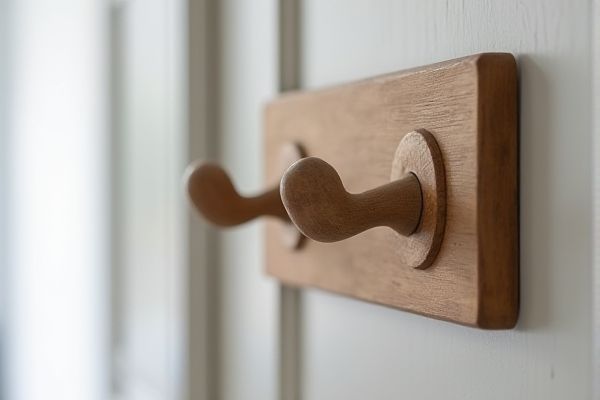
Wall hooks provide a sturdy, permanent solution ideal for maximizing vertical space, while over-the-door hooks offer easy installation and portability without damaging walls. Discover which option best suits your space and organizational needs by exploring the detailed comparison ahead.
Table of Comparison
| Feature | Wall Hooks | Over-the-Door Hooks |
|---|---|---|
| Installation | Requires drilling or adhesive for mounting | No drilling; simply hangs over door edge |
| Portability | Fixed; not easily movable | Highly portable and easy to reposition |
| Weight Capacity | Typically higher, supports heavy items | Moderate; best for lightweight to medium items |
| Door Compatibility | Not applicable | Fits standard door thickness; may not suit all doors |
| Surface Impact | May damage walls when removed | Minimal door damage, but potential door edge marks |
| Space Efficiency | Utilizes wall space effectively | Maximizes door space without wall use |
| Appearance | Varied designs; can be discrete or decorative | Generally functional; limited design options |
Introduction: Wall Hooks vs Over-the-Door Hooks
Wall hooks offer sturdy, space-saving storage solutions by anchoring directly into wall studs, ensuring durability for heavy items such as coats and bags. Over-the-door hooks provide versatile, no-drill installations ideal for renters or temporary setups, easily hanging over various door thicknesses without damaging surfaces. Choosing between them depends on weight capacity, permanence, and wall integrity to maximize organizational efficiency.
Installation: Ease and Tools Required
Wall hooks require drilling and anchors, needing a drill and screwdriver for secure installation, making them suitable for permanent use on drywall or wood surfaces. Over-the-door hooks install effortlessly by hanging over the top edge of a door, requiring no tools or hardware, ideal for temporary or damage-free setups. Your choice depends on whether you prefer a sturdy, fixed option or a quick, no-tools solution.
Space Efficiency and Room Suitability
Wall hooks maximize space efficiency by utilizing vertical wall areas without occupying floor or door space, making them ideal for small rooms or narrow hallways. Over-the-door hooks provide versatile storage without installation, suitable for renters or temporary setups but may reduce door clearance and are less effective in rooms with heavy door traffic. Selecting between these options depends on available wall space, door usage frequency, and desired aesthetic integration within the room.
Durability and Weight Capacity
Wall hooks, typically installed with screws or anchors, offer superior durability and higher weight capacity, often supporting up to 50 pounds or more depending on the wall material and hardware used. Over-the-door hooks rely on the door's thickness and material for stability, generally accommodating lighter loads around 10 to 20 pounds to prevent door damage or bending. Choosing wall hooks ensures long-term strength and reliability for heavy items like coats and bags, while over-the-door hooks provide convenience but limited weight-bearing capability.
Design Options and Aesthetic Appeal
Wall hooks offer a wide range of design options, from minimalist metal finishes to ornate vintage styles, allowing seamless integration with various interior aesthetics. Over-the-door hooks provide a functional yet less customizable appearance, typically designed in standardized shapes and materials to fit door frames. While wall hooks enhance room decor by serving as decorative accents, over-the-door hooks prioritize practicality over aesthetic appeal.
Versatility in Placement
Wall hooks offer versatile placement options and can be installed anywhere on solid surfaces like walls or ceilings, supporting heavier items and creating customized storage solutions. Over-the-door hooks provide convenience without installation, easily repositioned on various doors, making them ideal for renters or temporary setups. Your choice depends on balancing permanence and flexibility in optimizing your space.
Damage to Walls and Doors
Wall hooks often require drilling holes, which can leave permanent damage or marks on wall surfaces, particularly drywall. Over-the-door hooks avoid wall damage by hanging over the top edge of doors, but they may cause pressure dents or scratches on the door's finish over time. Choosing between the two depends on whether preserving wall integrity or minimizing door wear is the priority.
Cost Comparison and Value
Wall hooks typically range from $5 to $20 per set, offering durable installation and higher load capacity, making them ideal for heavy items and long-term use. Over-the-door hooks usually cost between $10 and $30, providing a non-permanent solution with easy installation but limited weight support and potential door damage. When evaluating cost versus value, wall hooks deliver better durability and stability for heavy-duty needs, while over-the-door hooks offer versatility and convenience at a slightly higher price point.
Maintenance and Longevity
Wall hooks typically offer greater durability due to their secure installation with screws or anchors, ensuring they withstand heavier loads and frequent use without loosening. Over-the-door hooks, which rely on door thickness and tension, may require periodic adjustment to prevent slipping and can be more prone to wear and tear from daily door movement. Proper maintenance of wall hooks involves occasional tightening and cleaning, while over-the-door hooks benefit from regular inspection to maintain optimal grip and prevent damage to door surfaces.
Choosing the Right Hook for Your Needs
Wall hooks offer sturdy support for heavy items like coats and bags, making them ideal for permanent organization in entryways or closets. Over-the-door hooks provide a versatile, damage-free option for renters or temporary spaces, easily hanging on most standard doors without installation tools. Selecting the right hook depends on the weight of items, space availability, and whether you prefer a fixed or portable organization solution.
 homyna.com
homyna.com